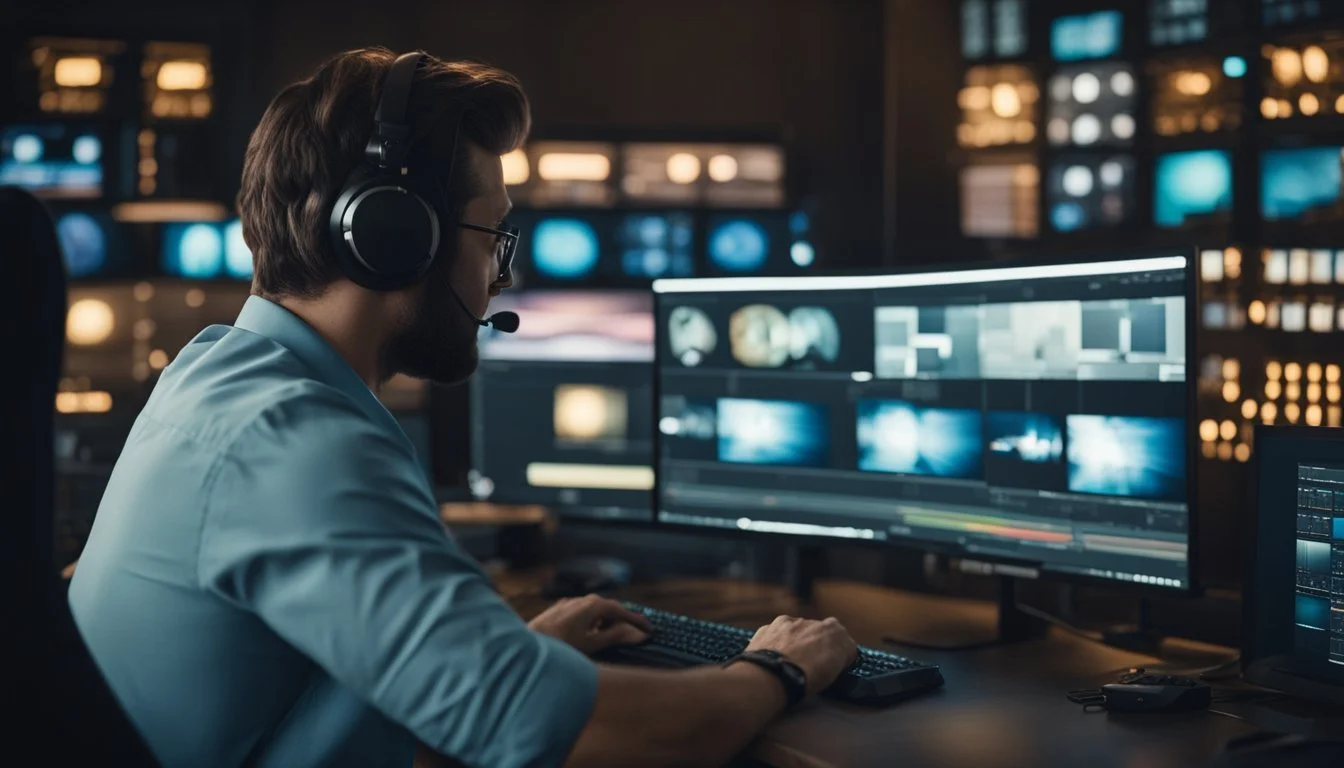The Role of the Film Colorist
Crafting Visual Tone and Mood in Post-Production
A film colorist is pivotal in shaping how a movie feels and looks once filming has wrapped. They meticulously manipulate color, contrast, saturation, and brightness to achieve the desired visual storytelling effect. By doing so, they not only enhance each frame’s aesthetic appeal but also ensure consistency across scenes, thereby keeping the audience engaged visually.
Collaborating closely with directors and directors of photography, colorists use specialized software to craft the film's final visual tone. They tackle various elements such as balancing colors, setting moods, and correcting any discrepancies to maintain a cohesive narrative. The impact of their work is evident in examples like "Mad Max: Fury Road," where vibrant and surreal landscapes were meticulously crafted to support the film's unique storytelling.
Being a colorist requires a keen eye for detail and a deep understanding of color theory. Their ability to transform raw footage into a visually compelling story demonstrates the essential role they play in post-production. Through their expertise, the emotional and visual resonance of a film is brought to life, making their contribution both essential and artful.
History and Evolution of Film Color Grading
Film color grading has transformed dramatically, moving from early experimentation with color to sophisticated digital techniques that shape a film’s mood and visual narrative. The journey covers manual efforts, technological advancements, and the emergence of advanced digital tools.
Origins of Color in Film
Early filmmakers experimented with color to enhance storytelling. Techniques like hand-painting each frame, tinting, and toning were employed in the silent film era to provide visual cues and emphasize emotions.
Notable examples include Georges Méliès’ fantastical innovations and D.W. Griffith’s use of tinted scenes. These initial methods were labor-intensive and inconsistent but set the stage for more systematic approaches.
Technological Advancements in Color Grading
Technological progress has driven significant changes in color grading. The introduction of Technicolor in the 1930s revolutionized the industry with its three-strip color process, bringing vivid imagery to classics like "The Wizard of Oz."
By the 1970s, computer-controlled color timing began to allow more precise adjustments. Benchmarks were set by films like "The Godfather" which used color to craft distinctive, moody tones.
Digital Color Grading Emergence
The late 20th and early 21st centuries marked the arrival of digital color grading. Systems like DaVinci Resolve enabled real-time manipulation of color with unprecedented accuracy. This period saw the development of color-grading software that allowed for infinite creative possibilities and seamless corrections, greatly enhancing visual storytelling.
Modern examples include "Avatar," where vibrant hues are used to create immersive, fantastical worlds, illustrating the profound impact of digital technology on film aesthetics.
Understanding the Role of a Film Colorist
A film colorist specializes in enhancing and manipulating the color palette of a film to achieve specific visual styles and moods. They work closely with directors and cinematographers to ensure that the color grading aligns with the film's narrative and artistic vision.
Defining the Colorist’s Responsibilities
A film colorist’s duties involve color grading, which includes adjusting and enhancing the colors of footage during post-production. This process ensures visual consistency and helps create the desired mood for different scenes.
They handle both color correction to fix any issues in the footage and creative grading to establish a unique look. Accuracy, technical skill, and artistic vision are critical to their work, requiring knowledge of specialized software and tools.
The Significance of Color in Storytelling
Color plays a vital role in conveying the emotional tone of a film. It can highlight themes, differentiate settings, and suggest a particular time of day or mood. For instance, warmer tones might be used to create a sense of comfort or nostalgia, while cooler tones can suggest tension or melancholy.
Colorists use their expertise to support the narrative, ensuring that each scene's color palette aligns with the director's intentions. This enhances the audience's emotional engagement and helps convey the subtleties of the story.
Collaboration with Directors and Cinematographers
Colorists closely collaborate with directors and cinematographers to achieve the film's visual goals. Regular meetings and reviews are essential in this collaboration, as the colorist must understand the creative vision and adjust the grading accordingly.
They also offer technical advice on how lighting and camera settings during shooting will affect the grading process. Effective communication and a deep comprehension of cinematic techniques are essential for colorists to bring the film’s visual narrative to life.
The Color Grading Process
Color grading is a meticulous post-production process that enhances and manipulates colors to achieve a desired visual tone and mood.
Step 1: Color Correction
Before creative grading begins, color correction adjusts any inconsistencies in the digital footage. This ensures a uniform look by balancing exposure, white balance, and contrast.
Step 2: Primary Grading
The first stage of grading adjusts overall color balance and contrast. It shapes the image by modifying shadows, midtones, and highlights. This foundational step sets the stage for more precise adjustments.
Step 3: Secondary Grading
This involves targeted adjustments in specific areas of the frame or to particular colors. Masks and tracking tools help isolate areas to fine-tune their appearance.
Tools and Software
Colorists utilize advanced tools such as DaVinci Resolve, Adobe Premiere Pro, and Final Cut Pro. These provide an array of options for detailed modification.
Creative Grading
Here, the colorist employs color theory to evoke specific emotions or highlight narrative elements. Techniques may include saturation adjustments, color shifts, and film emulation.
Consistency Across Shots
Ensuring a consistent visual style across scenes is crucial. Colorists meticulously match colors, contrast, and brightness to maintain coherence throughout the film.
Final Output Review
The graded footage undergoes thorough review. Revisions ensure the visual narrative aligns with the director's vision and storytelling requirements.
The color grading process transforms raw footage into a polished final product, elevating the visual storytelling to new heights.
Tools and Software Used in Color Grading
Color grading requires a combination of specialized hardware and software tools to achieve the desired visual tone and mood. These tools range from essential hardware like calibrated monitors and control panels to popular software applications such as DaVinci Resolve and Adobe Premiere Pro, as well as various plug-ins and LUTs.
Essential Hardware for Colorists
The foundation of color grading relies heavily on high-quality hardware. Calibrated monitors are crucial for accurate color representation, ensuring that what is seen on the screen reflects real-world colors. Control panels, featuring tactile knobs and buttons, provide precision and efficiency, allowing colorists to make swift and accurate adjustments.
Colorists also depend on powerful workstations equipped with high-end CPUs and GPUs. These machines handle the demanding computations necessary for real-time color grading. Storage solutions such as SSDs offer fast read/write speeds, ensuring smooth playback of high-resolution video files.
Popular Software Applications
Several software applications dominate the color grading landscape. DaVinci Resolve is a favorite among professionals due to its comprehensive suite of tools, including advanced color correction, keyframe animation, and color matching. It supports a broad range of formats and integrates seamlessly with various editing workflows.
Adobe Premiere Pro also offers robust color grading tools. Its Lumetri Color panel provides intuitive controls for basic and advanced grading. Final Cut Pro, geared towards Apple users, includes powerful built-in color correction features and supports third-party plug-ins for extended functionality.
The Impact of Plug-ins and LUTs
Plug-ins and LUTs (Look-Up Tables) enhance the color grading process by providing additional capabilities and creative options. Plug-ins can introduce unique effects, simplify complex tasks, and extend the functionality of existing software. They help tailor the color grading process to specific needs, making workflows more efficient and versatile.
LUTs are widely used to achieve consistent color styles across different scenes and projects. They serve as preset color profiles that can be applied to footage, allowing colorists to quickly establish a desired look. LUTs are particularly useful for ensuring uniformity in projects that require a specific visual style, such as commercials or feature films.
The Artistic Aspects of Color Grading
Color grading in film isn't merely a technical process, but an artistic endeavor that affects how audiences experience a story. Key areas include the application of color theory, psychological impacts of color, and how color creates mood and atmosphere.
Color Theory in Film
Color theory in film involves the use of colors to create visual harmony, contrast, and balance. Filmmakers often employ complementary colors to highlight characters or moments, while analogous colors create a more uniform look. The choice of a specific color palette can make scenes pop or blend seamlessly, guiding the audience’s focus and enhancing visual storytelling. Understanding the interplay of colors helps colorists create visually appealing and emotionally effective scenes.
Psychology of Color in Visual Storytelling
Colors can evoke emotions and guide the audience’s feelings in subtle yet powerful ways. Warm colors like red and yellow can induce feelings of warmth, excitement, or tension, while cool colors like blue and green can bring about calmness or sadness. The psychological impact of color is pivotal in scenes where the mood needs to be clearly expressed. Colorists strategically use these associations to support the narrative and deepen viewers' engagement with the story.
Creating Mood and Atmosphere through Color
Color contributes significantly to the mood and atmosphere of a film. Darker tones and desaturated colors are often used to create a somber or ominous atmosphere. Bright and saturated hues can make a scene feel lively or fantastical. By manipulating color, colorists can transform the same scene from serene to eerie, making the viewer feel the intended emotional weight. This artistic input is crucial in aligning the film’s visual aesthetic with its storyline.
Challenges in the Field of Color Correction
Film colorists often face unique challenges that require a delicate balance of both technical skills and artistic sensitivity. These challenges include balancing artistic and technical aspects, maintaining color consistency, and working efficiently within tight deadlines.
Balancing Artistic and Technical Aspects
Colorists not only need to have a keen eye for detail and aesthetics but also must understand the technical side of color correction. They work with sophisticated software tools to adjust color balance, contrast, and exposure. The challenge comes in ensuring that their artistic vision aligns with the technical possibilities and requirements of the project. They must collaborate closely with directors and cinematographers to meet artistic goals while technically executing the necessary adjustments seamlessly.
Maintaining Color Consistency
Maintaining color consistency throughout a film is crucial. Each scene must look visually cohesive, even if shot under different lighting conditions or at various times of day. Colorists use a variety of techniques and tools to match colors across scenes, ensuring that the visual flow of the movie remains uninterrupted. This task requires meticulous attention to detail and an in-depth knowledge of color theory. Any inconsistency can pull viewers out of the immersive experience, making consistency a critical yet challenging aspect of a colorist's job.
Workflow Efficiency and Deadlines
Meeting tight deadlines is another significant challenge for film colorists. Post-production schedules are often tight, with little room for error. Colorists must be efficient in their workflow, using software tools effectively and making quick yet precise decisions to keep the project on track. They also need to be adaptable, ready to make last-minute changes without compromising the film's visual quality. This constant balancing act between speed and accuracy is demanding but essential for delivering a high-quality final product.
Case Studies: Notable Examples of Color Grading
Effective color grading can significantly influence a film’s mood, tone, and visual narrative. These case studies highlight how strategic color decisions create iconic film experiences.
Iconic Films and Their Color Palettes
The Matrix (1999) exemplifies a groundbreaking approach. The film uses desaturated green hues within the simulated world. This is achieved through set and costume design combined with post color grading. This gives the simulation an eerie, digital feel.
Mad Max: Fury Road (2015) employs vivid, high-contrast colors to depict a surreal desert landscape. The bright orange and blue hues heighten the intensity and starkness of the post-apocalyptic world. This color treatment immerses the viewer deeply into the film’s harsh environment.
Amélie (2001) uses a warm, saturated palette to reflect the whimsical and quirky nature of its storyline. The dominant colors of red, green, and yellow support the film’s fantastical elements and the warmth of the protagonist’s world.
Analyzing Color Grading in Award-Winning Movies
La La Land (2016) won an Academy Award for Best Cinematography. Its vibrant color scheme helps distinguish different emotional phases of the protagonists' journey. Rich primary colors emphasize the romance and dreams of the characters, while muted tones indicate reality's harsher aspects.
Schindler's List (1993) stands out with its predominantly black-and-white palette, interspersed with instances of color. The red coat worn by a little girl profoundly impacts the narrative, highlighting innocence amidst chaos. This approach earned the film critical acclaim for its emotional depth.
Moonlight (2016) showcases subtle yet powerful use of color grading to explore the protagonist’s life stages. Shifts in color temperature reflect the different phases of the character's development, using hues like blue and purple to convey emotional nuance.
The Evolving Trends in Color Grading
Modern trends in color grading lean towards digital post-production enhancements. Today’s tools allow for advanced color correction and creative freedom.
Streaming services also push for higher standards in visual quality, driving innovations in color grading techniques tailored for various viewing devices.
Filmmakers now increasingly use dynamic color grading to create immersive experiences. By constantly tweaking color schemes, they can better adapt to evolving storytelling techniques and technological advancements, ensuring that each scene garners the desired audience reaction.
Future of Color Grading
As technology evolves, the field of color grading is set to experience significant transformations. Innovations in AI, machine learning, VR, and HDR are paving the way for new methodologies and tools that will revolutionize visual storytelling.
Advancements in AI and Machine Learning
AI and machine learning are becoming integral to color grading workflows. Algorithms can now analyze scenes and suggest appropriate color corrections, significantly reducing the time required for manual adjustments.
Colorists can leverage AI to automate repetitive tasks, allowing them to focus on the creative aspects of their work. This technology also offers capabilities such as automatic scene detection and color matching, enhancing efficiency and consistency across the film.
AI-driven tools are also capable of learning from past projects to improve future color grading suggestions.
Emerging Technologies and Innovations
Emerging technologies including real-time rendering and GPU acceleration are drastically changing how colorists work. Real-time rendering allows for immediate feedback, which is crucial for making quick adjustments during the editing process.
GPU acceleration speeds up the processing time for high-resolution footage, enabling colorists to handle more complex projects. These innovations are particularly beneficial in high-pressure environments like television and blockbuster film production.
The integration of cloud-based solutions is another significant advancement, facilitating smoother collaboration among filmmakers across different geographic locations.
The Growing Role of VR and HDR in Color
Virtual Reality (VR) and High Dynamic Range (HDR) are becoming more central to color grading. VR demands a new approach to color grading, as it requires 360-degree adjustments to maintain visual coherence across a spherical environment.
HDR, with its enhanced range of brightness and color, allows for more vivid and striking visuals. Colorists working with HDR must understand the intricacies of this format to fully utilize its potential, ensuring that each scene can leverage the broader color palette and increased contrast.
Both VR and HDR are challenging traditional color grading norms but offer unprecedented opportunities for immersive and visually dynamic storytelling.






